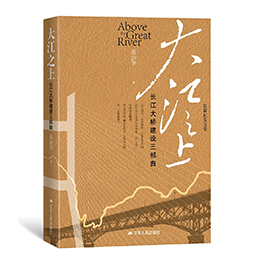Three bridges display development of PRC

Above the Great River
At the end of 2018, the Nanjing Yangtze River Bridge was reopened to the public after a 27-month overhaul. Zhang Jianhua, chairman of Jiangsu Provincial Federation of Literary and Art Circles, was inspired and decided to write a biography of the Yangtze River bridges and the several generations that were engaged in their construction. Above the Great River describes the construction processes of the Wuhan Yangtze River Bridge built in the 1950s, the Nanjing Yangtze River Bridge built in the 1960s, the Jiangyin Yangtze River Bridge built in the 1990s and other Yangtze River bridges in Jiangsu. These three bridges built in three eras reflect the historical development of the People’s Republic of China.
The reportage form is both a report and a literary work. Its popularity in modern and contemporary Chinese literature stems from the tradition of homology between literature and historical records in China. Above the Great River continues this tradition.
The book is divided into three parts. The first part mainly describes the construction process of the Wuhan Yangtze River Bridge, the first bridge on the Yangtze River, with the help of experts of the Soviet Union. The second part describes the construction process of the Nanjing Yangtze River Bridge, which was the first Yangtze River bridge built by China independently. The last part focuses on the construction processes of modern bridges represented by the Jiangyin Yangtze River Bridge and the Runyang Bridge, which reflects the vigorous development of China’s bridge industry after the reform and opening up.
Respect for history is the foundation of the creation of the book. Whether it is in the form of the technical assistance provided by the Soviet Union in the construction of the Wuhan Yangtze River Bridge or the factional struggles on the construction site of the Nanjing Yangtze River Bridge during the Cultural Revolution, Zhang Jianhua records these interesting stories objectively.
The description of characters in the book is particularly impressive. The images of bridge architects such as Peng Min, Mao Yisheng, Li Wenji, Mei Yangchun and Lin Ming are vividly portrayed, especially their sincere and simple inner worlds. In addition to intellectuals, the book also shapes the patriotism, missions and dedication displayed by construction workers such as Hu Baoling.
Above the Great River reveals the true emotions of these historical figures. For example, the friendship between Peng Min and the Soviet expert K.S. Silin runs through the account of the construction of the Wuhan Yangtze River Bridge and the Nanjing Yangtze River Bridge. Details such as Li Wenji and the frank expression of his patriotic feelings before the moment of his death are touching. During the construction of the Runyang Bridge, Lin Ming accompanied the workers to soothe their hearts.
China has numerous vivid stories and epic practices, but the real key is having the ability to tell these stories and the ambition to create epics. The book is a passionate response to the call for creating new epics of the Chinese nation.
edited by YANG LANLAN
